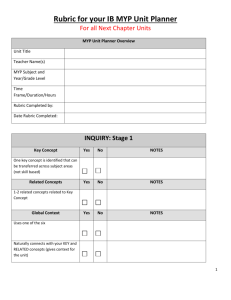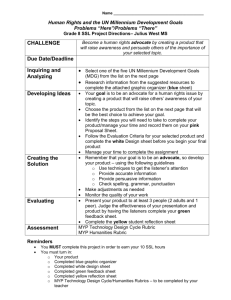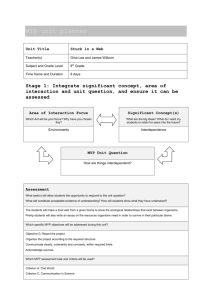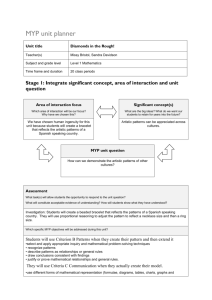NOT FOR PUBLICATION UNTIL RELEASED BY SENATE ARMED SERVICES COMMITTEE STATEMENT OF
advertisement
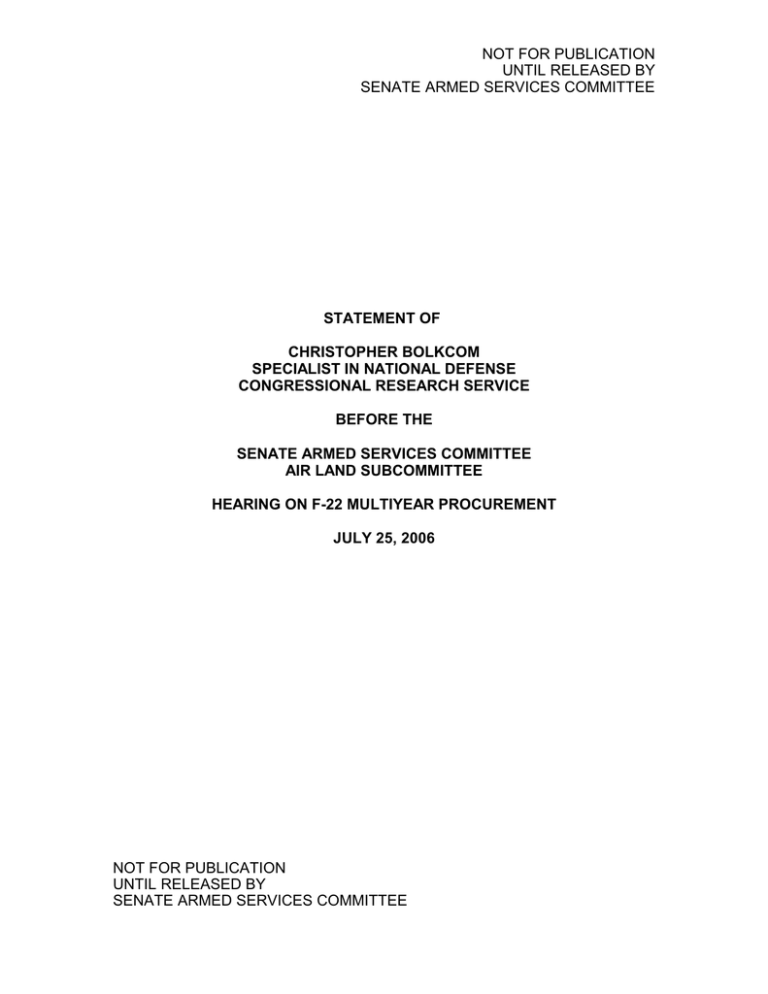
NOT FOR PUBLICATION UNTIL RELEASED BY SENATE ARMED SERVICES COMMITTEE STATEMENT OF CHRISTOPHER BOLKCOM SPECIALIST IN NATIONAL DEFENSE CONGRESSIONAL RESEARCH SERVICE BEFORE THE SENATE ARMED SERVICES COMMITTEE AIR LAND SUBCOMMITTEE HEARING ON F-22 MULTIYEAR PROCUREMENT JULY 25, 2006 NOT FOR PUBLICATION UNTIL RELEASED BY SENATE ARMED SERVICES COMMITTEE Mr. Chairman, distinguished members of the subcommittee, thank you for inviting me to speak with you today about the proposed multiyear procurement (MYP) of the F-22A. As you requested, my testimony will address whether the F-22A meets the MYP criteria in 10 U.S.C.§2306b, and the F-22 business case analysis, which the Air Force argues supports a three-year, 60-aircraft MYP. At the outset, it is important to note that the F-22 MYP proposal was presented to Congress this year as part of a larger package of proposed changes to the F-22 program. Other proposed changes include adding four additional aircraft to the planned total purchase, adding a production lot to the procurement plan, and slowing production to an annual rate of 20 aircraft per year over a longer schedule. Although Air Force arguments in favor of the proposed F-22 MYP sometime implicitly assume that these other proposed changes will be implemented, the approval of these proposed changes is not yet certain, as Congress has not yet completed action on the FY2007 budget. 10 U.S.C.§2306b MYP Criteria 10 USC §2306b contains a number of provisions governing MYP contract authority. Perhaps the most relevant for today’s hearing is 2306b subparagraph (i)(B) Defense Acquisitions Specifically Authorized by Law, which states that “the proposed multiyear contract provides for production at not less than minimum economic rates given existing tooling and facilities.” The Air Force proposes a three-year F-22 MYP of 20 aircraft per year. The prime contractor has provided conflicting information on whether this rate of production satisfies subparagraph (i)(B). On July 19, 2006, Lockheed Martin reported that the F-22’s minimum economic rate of production is 24 aircraft per year, which means that the MYP of 20 aircraft per year would apparently not comply with the statutory requirement.1 Upon further review, however, Lockheed Martin representatives changed their position, and reported on July 20, 2006 that the F-22’s minimum economic rate of production is “18-20” aircraft per year.2 It may be interesting to note that congressional staff met with DoD officials on July 19, 2006 and expressed concern that the proposed F-22 MYP might not meet the minimum economic rate of production requirement. 10 USC §2306b also contains six criteria for granting multiyear procurement authority for a major weapon systems. These subparagraphs pertain to: • (a)(1) substantial savings • (a)(2) stable requirement • (a)(3) stable funding • (a)(4) stable design • (a)(5) realistic contract cost and cost savings estimates • (a)(6) promoting national security. These general criteria are designed to help Congress evaluate the risks involved in allowing DoD to commit the Federal Government to spend funds that have not yet been appropriated. In the past, Congress has on occasion approved MYP, only to find that 1 Email communication between Lockheed Martin Co. and CRS July 19, 2006. 2 Email communication between Lockheed Martin Co. and CRS July 20, 2006. Page 2 of 12 programs did not always exhibit the stability, nor deliver the savings, which were promised. For example, RAND noted that despite award of MYP authority, the B-1B program experienced “technical and performance difficulties that have added to the cost of the program.” Compared to KC-10 and F-16 MYPs, “the B-1B program showed greater signs of instability at the time of its MYP than did the other two procurements...assessments at the time, however, did not flag these uncertainties.”3 The C-130J is a more recent example of an MYP that experienced, for example, requirements instability, funding instability, and controversy over the contract type, and specific contract clauses such as cancellation liability. Substantial Savings Multiyear procurement savings are typically estimated by comparing the cost to procure the same number of weapons systems under a series of single year procurement (SYP) contracts to the cost of a MYP contract over the same time period. When compared to past statutory requirements (10% savings), or to recent experience, some may not consider the projected F-22 MYP savings of 2.2% over three SYP contracts to be “substantial” as required under 10 U.S.C.§2306b.4 In its F-22 MYP Business Case Analysis (BCA), the Institute for Defense Analyses (IDA) compared the proposed F-22 MYP to 13 other MYP contracts. IDA found that the projected F-22 MYP savings compared unfavorably to these other case studies. The F-22's projected MYP savings of 2.2% is approximately one quarter the average estimated savings (8.0%) of these other MYP contracts. Expanding the survey beyond IDA’s data set reveals additional MYP contracts in which savings were estimated to be significantly greater than 2.2%. These additional MYP contracts are shown in the table below. Estimated MYP Savings of Historical Programs Program Estimated Savings (%) Javelin Anti Tank Guided W eapon 14.3 Medium Tactical Vehicle Replacement 7.4 CH-60 Helicopter 5.5 DDG-51 9 GPS Satellite 13 DSP I Satellite 5.7 DMSP Satellite 19.2 3 Analysis of Air Force Aircraft Multiyear Procurements with Implications for the B-2. (R-3990DR&E) RAND. 1991. 4 Some, but not all of these observations were shared with the Subcommittee at the March 28, 2006 hearing on Air Force and Navy tactical aviation programs in review of the Defense Authorization Request for Fiscal Year 2007 and the Future Years Defense Program. Page 3 of 12 DSCS II Satellite 18 Titan IV Expendable Launch Vehicle 15.1 DSP II Satellite 27.8 DMSP Satellite 18.1 Sources: An Overview of Acquisition Reform Cost Savings Estimates. RAND. 2001. Table 6.1, p.111. Analysis of Air Force Aircraft Multiyear Procurements with Implications for the B-2. RAND. 1991. p. 10. Similarly, a Congressional Budget Office (CBO) working paper estimates DoD saved an average of 11.7% in current dollars through MYP production contracts from 1982-1987.5 Responding to figures such as these, Air Force leaders have stated that the percentage savings is only one factor to consider when granting MYP authority. The absolute figure of dollars saved is also important, they argue. In terms of absolute savings, the IDA study found that the F-22's projected MYP savings of $225 million is roughly half the average $470 million in savings of the 13 MYP contracts it studied. It can also be noted that IDA’s savings calculation takes as its starting point an F-22 production profile that incorporates the Air Force’s proposals for adding four aircraft to the planned total purchase and for slowing the annual production rate to 20 aircraft per year over a longer schedule. Taking these two changes as a given in the MYP cost-savings calculation does not take account for the $1.8 billion in additional procurement funding requirements associated with implementing these two changes. It therefore appears that the cost savings of the F-22 MYP are almost certainly smaller than the $1.8 billion in additional funding associated with adding four aircraft and slowing the annual production rate. Conversely, the $1.8 billion in additional funding needed to implement these two changes may be more reason to seek offsetting savings through an MYP. It is possible, however, that greater savings could be achieved in the F-22 program without implementing an MYP by simply keeping production at 30 aircraft per year for two years. Realistic Cost Avoidance Estimates Another potential issue is whether the IDA study’s estimate of MYP cost avoidance (regardless of the study’s apparent analytical rigor) meets 10 U.S.C.§2306b’s requirement for realist cost avoidance estimates. In assessing whether IDA’s cost-savings estimate is realistic, one point to consider is that there is disagreement among IDA, the Air Force, and the Office of the Secretary of Defense (OSD) regarding the overall cost of the F-22 program. Skeptics could ask whether, in a situation where disagreement exists about the overall cost of program, it is possible to realistically estimate savings that might result from changing the program in some way. Another factor in assessing whether IDA’s estimated savings are realistic, is the track record of previous MYPs. Some MYP contracts do not appear to have achieved the cost savings that were “realistically” forecast prior to the granting of MYP authority. IDA’s own 5 “Alternative Strategies for Increasing Multiyear Procurement.” Staff Working Paper. Congressional Budget Office. July 1986. Table 3, p.17. Page 4 of 12 report, for example, notes that Studies analyzing the actual execution of MYPs have shown mixed results. For example, a previous IDA study could not find any evidence of cost savings for the first F-16 MYP, despite the 7.7 percent savings shown in the pre-MYP estimates reported here. A similar result was found for the Army’s H-60 helicopter program. GAO analysis corroborates IDA’s findings, and casts doubt on the accuracy of before-thefact MYP cost estimates. In an assessment of the FY84 DoD budget request, for example, GAO found that the funds requested for four MYP programs initiated in FY82 and FY83 exceeded the negotiated or proposed contract amounts by $197 million.6 RAND notes that “circumstances can easily create a bias in estimates of cost reduction that favor MYP contracting.”7 The IDA study recognizes this potential bias and contains a similar caveat. Stable Funding Funding stability is another criterion in 10 U.S.C.§2306b for multiyear procurement. If a weapon system candidate for MYP has a history of unstable funding, it may suggest “an unstable requirement, a relatively low funding priority, or wavering support, thus rendering the system inappropriate for multiyear contracting.” 8 A review of recent F-22 funding profiles, as depicted in the table and chart below, raises questions as to whether the Raptor’s funding has been stable enough to warrant an MYP commitment. The three lines in the chart represent the Air Force’s annual budget requests and Future Years Defense Plan funding projections for the F-22 in FY05 (President’s Budget, or PB05) FY06 (PB06), and FY07 (PB07). $ M illions PB FY05 FY06 FY07 FY08 FY09 FY10 FY11 Total 07 3552 3144 1503 2934 2919 1724 261 28493 06 3548 3186 3811 4175 113 56 257 27601 05 3633 3571 3817 3716 3569 5601 to com plete 36343 Source: Department of the Air Force. Exhibit P-40, Budget Item Justification, Aircraft Procurement, Air Force, Budget Activity 01, Combat Aircraft. Various years. 6 Analysis of Fiscal Year 1984 Budget Requests for Approved Multiyear Procurements. (GAO/NSIAD-83-57). General Accounting Office. September 30, 1983. 7 RAND. (R-3990-DR&E) opcit. p. vi 8 F-22 Multiyear Procurement Business Case Analysis (BCA). Institute for Defense Analyses. May 2006. p.10. Page 5 of 12 A budget that does not contain sufficient funds to pay for planned expenditures, or protect against unplanned contingencies, can raise questions concerning future funding stability. The Air Force’s request to incrementally fund F-22 procurement over the proposed MYP may be viewed as an indication that procurement funds are limited. The Air Force has no precedent of incrementally funding aircraft procurement. Incremental funding is viewed by Congress as unorthodox and an exception to the full funding rule. Why, it might be asked, would the Air Force request incremental funding of F-22 procurement if it believed it had sufficient budget authority to fully fund F-22 procurement? Also, GAO reports the current Air Force request under-funds the F-22 program through the Future Years Defense Plan by $647 million.9 CBO similarly expresses concern that the Air Force “is not requesting appropriations sufficient to cover the potential cancellation liability. Under the proposal for multiyear procurement, the Air Force would have to seek additional appropriations in the future even if a decision was made to cancel the contract.”10 The Air Force and other F-22 supporters argue that the Raptor has been for many years the Service’s top acquisition priority, and that the Service is fully committed to funding the program. Few observers if any appear to doubt the Air Force’s commitment to the F-22 program. The Air Force, however, does not have complete control over its budget. The actions of other government actors, especially in what may be a budgetary environment of 9 “Tactical Aircraft: DOD Should Present a New F-22A Business Case before Making Further Investments.” (GAO-06-455R). Government Accountability Office. June 20, 2006 10 Statement of Donald Marron, Acting Director Statement before the Senate Armed Services, Air Land Subcommittee. March 28, 2006. Page 6 of 12 increased turbulence, may create risks for a plan to commit now to procuring certain numbers of F-22s in future years. Weapon procurement for all of DoD is expected to cost approximately $1.4 trillion between 2006 and 2009, with more than half of these expenditures yet to be made.11 In addition, it is possible that in the near future the preponderance of funding for conflicts in Afghanistan and Iraq will need to be requested through the annual budget, rather than emergency supplementals. Such a change could lead to dynamics in the budget process that are difficult to predict. Stable Requirement The number of F-22's to be purchased has fluctuated considerably over time. Originally conceived of as a 750-aircraft program, DoD’s first Selected Acquisition Report that included the F-22 (December 31, 1991), reported a 648-aircraft procurement plan. Over time, the number of F-22s that could be purchased under budget limits was reduced to 442, 440, 342, 341, 278, 279, 181, and 185 (including aircraft built with RDT&E funds). The Air Force called its attempts to purchase as many F-22's as possible under budget limits a “buy-tobudget” plan. Some criticized this approach as being inconsistent with DoD’s more traditional requirements-driven weapon system acquisition strategy. Since 2002, Air Force leaders have consistently stated that they require 381 F-22s. Further, Air Force officials point out that this requirement has been validated by DoD. The Air Force’s stated rational for the 381 figure has not been consistent. At times Air Force officials have argued that this figure is required to field one 24-aircraft F-22 squadron in each of the Service’s 10 Aerospace Expeditionary Forces (AEFs). Other times, the Air Force has argued that 381 was the minimum number required to address emerging “nearpeer” competitors. At still other times, Air Force leaders argued for the F-22, based on their perception of the Raptor’s potential contribution to the “global war on terrorism.” Specific F-22 missions Air Force leaders described include conducting cruise missile defense over the United States, and flying close air support (CAS) missions for small, dispersed U.S. ground forces fighting terrorists or insurgents. It is also important to note that although DoD may support the 381-aircraft goal for the F-22 in theory, DoD has cut the F-22 program by $10.5 billion. This reduction has made the 381 requirement difficult to achieve. Stable Design Another MYP criterion in 10 U.S.C.§2306b is for the program to have demonstrated a stable design. F-22 supporters argue that flight testing is complete, the aircraft is operational, and 75 Raptors have been delivered to the Air Force. These factors, they argue, demonstrate that the F-22 design is stable. Critics argue that technical issues have emerged since late 2005 that create the possibility of additional changes to the F-22 design or production process. The cited technical challenges include the following: 11 Leslie Wayne. “Pentagon Struggles with Cost Overruns and Delays.” New York Times. July 11, 2006. Page 7 of 12 1) Structures Retrofit Program (SRP) As service life deficiencies were identified during Engineering, Manufacturing and Development (EMD), corrections were incorporated into the production line. The SRP will retrofit those aircraft delivered prior to the incorporation of all corrective actions into the F-22 production process. Work will begin as early as January 2007 and is scheduled to conclude in 2010. 2) Forward Boom Heat-Treat Issue. In December 2005, the Air Force was notified that some titanium forward boom frames were not properly heat-treated. This improper heat treatment creates the potential for anomalous material properties (e.g. extensive cracking) in 91 aircraft. The Air Force asserts that this is not a safety of flight issue. The contractor responsible reportedly has stated that “the root cause has yet to be determined.”12 3) Canopy Actuator. On April 10, 2006, an F-22 pilot was trapped by a canopy that would not open. A fleet-wide inspection identified 42 potentially faulty actuators. A 30-day repetitive mechanical inspection has been implemented to ensure proper operation of the actuators. The Air Force plans to replace all potentially faulty actuators by February 2007. 4) Air Recharge System. The Air Recharge System (ARS) experienced three problems: leakage, auto-ignition failures, and a rupture during flight. The ARS replenishes the Stored Energy System after engine start. Air Force officials say that fixes to these problems have been initiated. 5) Nose Landing Gear. On May 11, 2006, an F-22 experienced an uncommanded nose landing gear retraction and the nose of the aircraft fell to the ground, landing on the main weapons bay doors. A similar incident occurred on March 18, 2003. The technical solution preventing uncommanded nose gear retractions has been incorporated into the production process and is being fielded throughout the fleet. The findings of a Safety Investigation Board are pending. GAO and others have expressed concern that the Air Force’s plan to integrate a new, multi-mode, air-to-ground-capable AESA (Agile, Electronically Steered Array) radar into the F-22 could present unforeseen and significant technical challenges. Although GAO agrees with the Air Force that the design for the baseline F-22A aircraft, designed primarily for an air superiority role, is stable, GAO states that “the ground attack capability to be added has not been demonstrated and thus cannot be considered ‘stable.’”13 In its August 2005 Independent Cost Estimate (ICE), the Institute for Defense Analyses (IDA) appeared to concur with the GAO position: We think there is little threat to design stability from problems that might be found in the last states of the EMD program. However, the extensive Modernization Program now in its initial states could affect the future production air vehicle configuration such that favorable downward cost trends evident in current data are disturbed.14 The Air Force does not share GAO’s and IDA’s concern. It asserts that modernizing 12 13 14 Laura Colarusso. “Contractors Blamed for F-22A Faults.” Defense News. June 26, 2006. GAO-06-455R op cit. F/A-22 Independent Cost Estimate. Institute for Defense Analyses. August 2005. p.15. Page 8 of 12 the F-22 radar is no more challenging than, for example, retrofitting existing F/A-18/E/F Super Hornets with new AESA radars. IDA F-22 MYP Business Case Analysis (BCA) As requested, CRS studied the IDA “F-22 Business Case Analysis” (BCA) to critically assess its task objectives, approach and results. Study Approach The IDA study appears at first inspection to be a logically designed and thorough estimate of potential cost avoidance from MYP contracting. Observations can be made, however, about some of the study assumptions or methodologies that could bring into question the accuracy of the savings estimate. For example, IDA estimated that for the avionics sub-contractor to achieve a 5% cost savings, the MYP contract would have to be in place by August 2, 2006. If the contract is delayed past that point, IDA estimated that the savings would fall to 4%. Due to the uncertainty of this event, IDA split the difference, and counted 4.5% savings in its estimate. The Air Force reports that the MYP contract award is currently scheduled for May 2007, and sees “no possible means to accelerate MYP contract award to August 2006.”15 Even if this contract award could be accelerated, FY07 advance procurement funding cannot be obligated prior to the signature of the FY07 appropriations and authorization acts. A CRS review of defense authorization and appropriations bills from 1970 to the present indicates that authorizations have been signed into law by August 1st only three times. No appropriations bills during this time period were signed into law by August 1st. Based on this historical experience, the chance of completing the FY07 defense authorization and appropriations process by August 2, 2006 appears to be remote. Thus, MYP avionics savings are expected to be 4% (at best) per IDA’s calculation, not 4.5%. Other witnesses may find additional assumptions or methodologies in the IDA study that they believe weaken or strengthen the estimate of 2.2% MYP cost avoidance. Scrutinizing and critiquing IDA’s cost estimate of F-22 MYP cost avoidance, however, may have only marginal value in assessing the pros and cons of granting the Air Force MYP authority to purchase 60 aircraft over three years. Task Objectives It may be that the IDA study’s task objectives limit the value of its findings for assessing the pros and cons of F-22 MYP. The FY2006 Defense Appropriations conference report directed DoD to perform a comprehensive assessment of alternatives for the continued acquisition of the F-22. Specifically: The report should consider, but not be limited to, the following: analyses of the advantages of a multiyear procurement program, of extending the F/A–22 procurement profile, and of the effects of F/A–22 procurement on the Joint Strike Fighter production 15 Fact Sheet. July 11, 2006. Provided to CRS by SAF/LLW. Page 9 of 12 line.16 The IDA study notes that its task was to “estimate the cost savings to the Government of pursuing an MYP contract for the three planned lots of the F-22A. (Emphasis added).” Thus, IDA did not analyze the advantages of extending the F-22 procurement profile. Instead, it considered extending the procurement profile as a given.17 Air Force representatives report that slowing down F-22 production to 20 aircraft per year will “create upward cost pressure” that would be mitigated, in part, by the savings realized with multi-year procurement.18 The increased costs associated with producing 60 F22s over three years is at least $1.8 billion.19 A robust business case analysis, and one that would completely fulfill the congressional tasking might have, for example, compared the pros and cons of a 60-aircraft, three-year MYP to a 60-aircraft, two-year MYP. All things being equal, a two-year MYP would be expected to save less money than a three-year MYP. However, by procuring aircraft over two years at the more economic rate of 30 per year, the Air Force may avoid much of $1.8 billion in cost growth, which would be much greater than the $225 million projected to be saved through MYP. The Air Force did not task IDA to analyze the effects of F-22 procurement on the Joint Strike Fighter production line. The two programs are closely associated, and greater clarity of how changes to one program may affect the other would appear to be valuable. Air Force and DoD leaders assert that extending the F-22 production line is a prudent hedge against any potential delay in the JSF program. Since these aircraft compete for limited budget authority, however, extending the F-22 production line arguably could contribute to delay in the JSF program. If extending the F-22 line did push some JSF production further into the future, the added costs of this delay would offset the perceived advantages of extending the F-22 production line. Such an analysis would be useful in informing congressional decisions about whether to extend the F-22 production line and how to fund it. Results Although Air Force leaders tout the IDA study as a business case for their plan to procure 60 F-22s over three years via an MYP contract, the IDA study does not validate or endorse the MYP strategy. IDA was not asked to examine the MYP criteria pertaining to funding stability, requirements stability, or design stability. Nor was IDA asked to address congressional concerns about extending the F–22 procurement profile, or the potential impact on the Joint Strike Fighter. IDA provides an MYP cost saving estimate, but does not judge whether these potential savings are substantial and whether they satisfy statutory 16 H.R. 2863 (H.Rept. 109-359), p. 314. 17 It may be important to note that IDA began the BCA in January 2006. This date is before the official submission of the FY2007 DoD budget request that proposed modifications to the F-22 production and funding profile. The Air Force tasked IDA to conduct this BCA prior to the congressional defense committee hearings on this request, and thus with no knowledge of what action the committees might take. 18 CRS meeting with SAF/AQPS and F-22 Program Office. March 8, 2006. 19 The Air Force’s FY07 plan to procure 60 aircraft over three years of production is $1.134 billion more than the FY06 plan to fully fund 56 aircraft over two additional years of production. $674 million more is required to fully fund the plan, bringing the cost increase to $1.8 billion. Page 10 of 12 requirements. Many observations in the IDA study do not appear to be particularly favorable to the Air Force’s argument for MYP. For example, IDA estimates MYP cost avoidance at approximately half of what the Air Force testified the MYP cost savings would be.20 As mentioned earlier in this testimony, IDA found that the estimated F-22 MYP savings, both as a percentage of SYP and in absolute terms, compared unfavorably to 13 other MYP contracts. The IDA study makes observations about the F-22 MYP that appear to be at odds with Air Force statements, or could be perceived as detrimental to Air Force arguments that the F-22 meets 10 U.S.C.§2306b MYP criteria. For example, F-22 supporters describe the F-22 MYP proposal as an orthodox funding strategy. 21 However, IDA notes that elements of this proposal are unorthodox. The F-22 MYP’s “shorter contractual period of performance...translates into a more abbreviated investment horizon than is typical in a multiyear procurement.22” Further, the IDA study notes: Given a 3-year period of performance, the amount of time available to recoup investments in longer-term projects is limited. In fact, during our review, some suppliers indicated that components with long lead times in excess of 12 months essentially decrease the 3year investment horizon down to just 2 years in certain cases. In summary, each of these considerations reduces the potential of multiyear savings for the F-22A program over conventional multiyear scenarios.23 The criteria in 10 U.S.C.§2306b are intended to ensure that a program is stable before entering into an extended contractual commitment. Air Force leaders disagree with critics’ arguments that the F-22 program does not meet this stability requirement. The IDA study recognizes, however, that “The F-22A program has undergone significant change since IDA completed its F/A-22 ICE in August 2005.”24 Some may interpret the “significant change” that IDA observes to be an antonym for the stability that 10 U.S.C.§2306b requires. IDA makes observations on F-22 production that may not “make the case” for MYP. These observations could be interpreted as supporting the Air Force position that production is stable, or as supporting the GAO position that “The F-22 entered production without ensuring production processes were in control.”25 For example, IDA notes that “Whereas 20 On March 28, 2006, LtGen Donald Hoffman testified to the Senate Armed Services Committee Air Land Subcommittee that he believed the IDA study would show an MYP would save “about 5 percent -- plus or minus 1 percent ”over SYP. 21 On March 28, 2006, LtGen Donald Hoffman testified to the Senate Armed Services Committee Air Land Subcommittee that “we don't view multi- year as unorthodox at all. That's standard practice for any long-term production run.” 22 IDA BCA. op cit. p.15 23 Ibid. p.16 24 Ibid. p.4. 25 Defense Acquisitions: Assessments of Selected Major Weapon Programs. (GAO-05-301) Government Accountability Office. March 31, 2005. p..63. Page 11 of 12 deliveries were 6 to 9 months late, they are now on the order of 1 to 2 months late.”26 The Air Force may wish to use this observation to highlight the improvement in delivery schedule. Others could note, however, that F-22 deliveries are still late, suggesting on-going problems in the production process. Another issue concerns weight growth which, all else held equal, is generally detrimental to aircraft performance. IDA notes that “airframe weight has increased over 500 lbs between aircraft numbers 4028 (Lot 2) and 4041 (Lot 3), while the weight has increased by less than 150 lbs between 4041 (Lot 3) and 4108 (Lot 6).”27 One could infer from this finding that improvements are being made to the production process. On the other hand, although weight growth may have slowed, it still continues, and the weight growth is cumulative. The 150lbs that production added to the airframe during Lot 3 production, for example, is on top of the 500 lbs that were added to the airframe earlier. Later aircraft are 650lbs heavier than earlier-built aircraft. Mr. Chairman, this concludes my remarks. I appreciate the opportunity to appear before you, and look forward to any questions your or the other subcommittee members may have. Thank you. 26 IDA BCA. op cit. p.4 27 Ibid. p.7 Page 12 of 12

